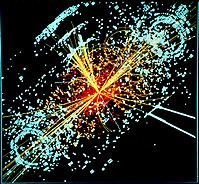
Photo from wikipedia
We study the gravothermal evolution of dark matter halos in the presence of dissipative dark matter self-interactions. Dissipative interactions are present in many particle-physics realizations of the dark-sector paradigm and… Click to show full abstract
We study the gravothermal evolution of dark matter halos in the presence of dissipative dark matter self-interactions. Dissipative interactions are present in many particle-physics realizations of the dark-sector paradigm and can significantly accelerate the gravothermal collapse of halos compared to purely elastic dark matter self-interactions. This is the case even when the dissipative interaction timescale is longer than the free-fall time of the halo. Using a semianalytical fluid model calibrated with isolated and cosmological N-body simulations, we calculate the evolution of the halo properties-including its density profile and velocity dispersion profile-as well as the core-collapse time as a function of the particle model parameters that describe the interactions. A key property is that the inner density profile at late times becomes cuspy again. Using 18 dwarf galaxies that exhibit a corelike dark matter density profile, we derive constraints on the strength of the dissipative interactions and the energy loss per collision.
Journal Title: Physical review letters
Year Published: 2019
Link to full text (if available)
Share on Social Media: Sign Up to like & get
recommendations!